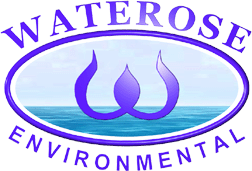 | ||||||
| Articles | Projects | Resume | Cartoons | Windsurfing | Paintings | Album |
Pollution Decreasing Technologies in the
Pulp and Paper Bleaching Process
by Waterose

The Canadian Chlorinated Substances Action Plan aims to reduce the amount of harmful chlorinated substances that enter the environment as a result of human activity (Action, Internet). The Canadian Chlorine Coordinating Committee (C4) identifies harmful chlorinated substances produced by specific industries and implements programs for reduction of these substances by industry sectors, including the pulp and paper industry.
The pulp and paper industry primarily uses the Kraft process to manufacture paper pulp (Hocking, 1984). The pulp is bleached with elemental chlorine gas (Cl2) to remove residual lignin and whiten the pulp color. The chlorine forms organic compounds in the process, including dioxins and furans (Shariff, 1996). These and other AOX (adsorbable organic halogens) (CEPA,1991) are released in the effluent into the environment and contaminate fisheries (Hodson, 1997). In British Columbia (BC) elevated levels of dioxins and furans in fish and shellfish led to the closure of fisheries and the implementation of new federal regulations in 1992 (Fisheries, 1997). New technologies have been implemented by this industry in Canada that have reduced the release of dioxins by and furans by more than ninety-nine per-cent since 1988 (NOPP, 1996).
The objective of the new technology is to reduce the amount of chlorine introduced into the environment (Cross, 1998). This is accomplished by either the use of elemental chlorine free technology (ECF) or the use of totally chlorine free technology (TCF) (Eka, 1993). The TCF process uses a combination of hydrogen peroxide, oxygen pre-bleaching, a chelating agent, and ozone treatment. TCF pulp is more expensive than pulp produced by the ECF process (Eka, 1993).
The ECF process uses a lower ratio of chlorine to lignin by using chlorine dioxide (Shariff, 1996). Chlorine dioxide is so unstable that it cannot be transported and must be manufactured on site (Cross, 1998). Larry Cross describes the process as follows. The fundamental reaction for this process is:

The gaseous chlorine dioxide is injected into water to form an aqueous chlorine dioxide that is reacted with the pulp. Furthermore, according to Larry, more recent technology has eliminated the production of chlorine gas. The MacMillan Bloedel pulp mill located in Powell River installed ECF technology in 1992 at a cost of more than twenty million dollars and does not produce chlorine gas as a by-product (Cross, 1998). Consequently, dioxins and furans levels have dropped significantly (NOPP, 1996) and non-commercial harvesting of crab is permitted in the Powell River area (Fisheries, 1997).
In addition to reducing dioxins and furans, the industry is concerned about reducing AOX and other substances that are deleterious to fish (CEPA, 1991). These include resin acids, alcohols, chlorates, heavy metals, chelating agents, and naturally occurring compounds (Eka, 1993). The mill effluent contains a very high biological oxygen demand (BOD) and dissolved organic (DOC) carbon which creates a heavy stress load on the receiving environment for consumption of oxygen (Hodson, 1997). This effluent is commonly treated with micro-biological organisms to reduce the BOD, COD, and other harmful constituents (Teng, 1998).
Even with new technology, such as TCF and EFC, it is estimated that as much as three per cent of the black liquor from the Kraft process control may spill onto the floor of the plant and get washed into the environment. There are other possible sources of toxicants entering the waste stream, including resins that naturally occur in wood. Larry Cross speculates that in some cases, AOX not originating in the manufacturing process may originate from pesticide spraying of the forest block prior to harvest cut. Furthermore, dioxins can enter the waste stream if the hog-fuel is contaminated with chlorine or if Poly CP-contaminated chips originate from a supplier (Berry, 1997). The industry and government continues to monitor the levels in the receiving waters of these harmful substances and research continues on a regular basis (Hatfield, 1996).
The reduction of dioxins and furans from pulp mill point sources in Canada is a success story in significantly reducing harmful pollutants entering the environment through the application of improved technology. Technology continues to look for new ways to reduce or eliminate the use of harmful reagents used or produced in the manufacturing process such as chlorine gas. In addition, the use of closed loop systems illustrate both an economic benefit in the recovery of reagent chemicals, and more importantly, that it is viable to practice the precautionary principle. Technology is a significant contributor to implementing the precautionary principle as illustrated in the significant changes made in the pulp and paper industry.
References:
Written for Royal Roads University ES403 Industrial Processes and Pollution Prevention Lecture SeriesThe Action Plan. 1996. Canada’s Approach to Chlorinated Substances. Environment Canada. Internet URL: http://www.doe.ca/csap/canap_en.html
Berry, R. 1997. Miscellaneous Report: Dioxins and Furans in Pulp, Effluents, and Solid Waste. Pulp & Paper Research Institute of Canada. Pointe-Claire, Quebec.
CEPA. 1991. Canadian Environmental Protection Act. Priority Substances List Assessment Report No. 2. Effluents from Pulp Mills Using Bleaching. Government of Canada.Environment Canada. Health and Welfare Canada.
Cross, L. Chemical Engineer. Personal Interview. Port Alberni Mill Tour. Wednesday, April 29, 1998. MacMillan Bloedel Limited. Alberni Pulp & Paper Division. Port Alberni, B.C.
Eka Nobel. 1993. The White Book on While Paper. Wedlinder Advertising. Stockholm, Sweden. Pg. 78.
Fisheries and Oceans Canada & Health Canada. 1997. News Release. Monitoring Shows Dioxin Levels in Crab Continue to Decline. NR-PR-97-46E.
Hatfield Consultants Ltd. 1996. Strait of Georgia Fisheries Sustainability Review Summary Report. Hatfield Consultants Limited. West Vancouver, B.C. Pp. 26.
Hocking, M.B. 1984. Production of Pulp and Paper. In Royal Roads Environmental Science Laboratory Manual. Appendix XI. pp.301-335. Victoria, B.C.
Hodson, P. Et al. 1997. MFO Induction in Fish by Spent Cooking Liquors from Kraft Pulp Mills. In Royal Roads Environmental Science Laboratory Manual. Appendix XII. pp.908-916. Victoria, B.C.
NOPP, Environment Canada. 1996. Dioxin and Furan Compliance Report. Pp 33.
Shariff, A. Et al. 1996. An Assessment of the Formation of 2,3,7,8-TCDD and 2,3,7,8-TCDF when Chlorine Dioxide is the Oxidizing Agent in the First Stage of the Bleaching of Chemical Pulp. In Royal Roads Environmental Science Laboratory Manual. Appendix XIII. pp.31-11. Victoria, B.C.
Teng, T. Microbiologist. Telephone Interview. February 18, 998. MacMillan Bloedel Limited. Powell River Manufacturing Division. (250)-483-2850. Powell River, B.C.
Return to Index of Articles

 email Waterose
email Waterose
Please Sign My Guestbook
Please View My Guestbook

| Articles | Projects | Resume | Cartoons | Windsurfing | Paintings | Album |
 | ||||||